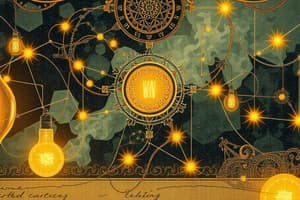Podcast
Questions and Answers
What is the unit of electric current named after André-Marie Ampère?
What is the unit of electric current named after André-Marie Ampère?
- Ampere (correct)
- Ohm
- Watt
- Volt
What did Ohm's work establish a fundamental relationship between?
What did Ohm's work establish a fundamental relationship between?
- Voltage and current (correct)
- Electric currents and resistance
- Magnetic field and electric currents
- Resistance and voltage
What is the resistance of the wire in the electric heater if it needs to work by passing a current of 100 amperes through it?
What is the resistance of the wire in the electric heater if it needs to work by passing a current of 100 amperes through it?
- 10 ohms
- 110 ohms
- 100 ohms
- 1.1 ohms (correct)
What is the resistance in the circuit if a Walkman uses a standard 1.5 V battery and a current of 0.01 A?
What is the resistance in the circuit if a Walkman uses a standard 1.5 V battery and a current of 0.01 A?
What is the resistance of the subwoofer that requires a household voltage of 110 volts to push a current of 5.5 A through its coil?
What is the resistance of the subwoofer that requires a household voltage of 110 volts to push a current of 5.5 A through its coil?
What does Ohm's Law establish the relationship between?
What does Ohm's Law establish the relationship between?
Who is renowned for inventing the electric battery in 1800?
Who is renowned for inventing the electric battery in 1800?
In Ohm's Law, what does the symbol 'V' represent?
In Ohm's Law, what does the symbol 'V' represent?
What did Georg Simon Ohm formulate in 1827?
What did Georg Simon Ohm formulate in 1827?
What concept did Volta's experiments with chemical cells provide the foundation for?
What concept did Volta's experiments with chemical cells provide the foundation for?
Flashcards are hidden until you start studying
Study Notes
- Ohm's Law, formulated by Georg Simon Ohm in 1827, is a fundamental principle in electrical engineering and physics, establishing the relationship between voltage, current, and resistance in an electrical circuit.
- Ohm's Law is expressed mathematically as: V = I × R, where V represents voltage, I denotes current, and R signifies resistance.
- According to Ohm's Law, in a circuit with a constant temperature, the current flowing through the circuit is directly proportional to the voltage applied across it and inversely proportional to the resistance.
- Georg Simon Ohm did not discover volts and current but established a fundamental relationship between these quantities, revolutionizing the understanding of electricity.
- Alessandro Volta, an Italian physicist, is renowned for inventing the electric battery in 1800, providing the foundation for the concept of voltage, and the unit of measurement for electrical potential difference is named after him.
- André-Marie Ampère made significant contributions to the understanding of electric currents and formulated Ampère's circuital law, which describes the magnetic field produced by electric currents, and the unit of electric current is named after him.
- An alarm clock draws 0.5 A of current when connected to a 120-volt circuit. To find its resistance, use the formula: R = V / I, resulting in a resistance of 240 Ω.
- A toaster produces 12 ohms of resistance in a 120-volt circuit. To find the current, use the formula: I = V / R, resulting in a current of 10 A.
- An electric heater works by passing a current through a coiled metal wire, making it red-hot. To find the voltage required to pass a current of 100 A through a wire with a resistance of 1.1 Ω, use the formula: V = I × R, resulting in a voltage of 111 volts.
- A subwoofer needs a household voltage of 110 volts to push a current of 5.5 A through its coil. To find its resistance, use the formula: R = V / I, resulting in a resistance of 20 Ω.
- A Walkman uses a standard 1.5 V battery. To find the resistance in the circuit when it uses a current of 0.01 A, use the formula: R = V / I, resulting in a resistance of 150 Ω.
- In a practice set with a 1.5-volt battery and a bulb with a resistance of 3 Ω, calculate the current using the formula: I = V / R, resulting in a current of 0.5 A.
Studying That Suits You
Use AI to generate personalized quizzes and flashcards to suit your learning preferences.




